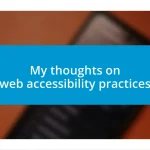Key takeaways:
- Embrace client feedback as an opportunity for growth and a means to build trust and collaboration.
- Implement structured feedback collection processes, ensuring timely engagement to allow for real-time adjustments.
- Evaluate the impact of changes based on feedback, fostering ongoing communication and enhancing project outcomes.

Understanding client feedback importance
Client feedback is crucial; it acts like a compass guiding us toward success in projects. I remember a time early in my career when I received feedback that completely shifted my perspective on a project. Initially, I was resistant, but as I listened, I realized that the client’s insight pinpointed issues I hadn’t even considered—it’s incredible how they see things from a different angle.
Have you ever had a moment where feedback felt overwhelming? I’ve been there, but instead of feeling discouraged, I learned to embrace it as an opportunity for growth. Each piece of feedback offers a chance to refine my approach and elevate the project quality. Understanding this allowed me to transition from a reactive to a proactive mindset in my work.
Ultimately, client feedback is more than just a collection of opinions; it is the key to building trust and fostering collaboration. I’ve found that when clients feel heard, it deepens our relationship, paving the way for a more successful partnership. It’s a win-win situation that benefits both parties immensely.

Developing a feedback collection process
To develop an effective feedback collection process, it’s essential to establish clear channels through which clients can share their thoughts. I’ve often used structured methods, such as surveys or one-on-one meetings, to ensure clients feel comfortable voicing their opinions. By offering various options, I’ve found clients are more willing to engage, which ultimately enriches the feedback I receive.
One key aspect of this process is timing. Gathering feedback too late can lead to missed opportunities for improvement. I learned this the hard way in a project where I waited until the end to solicit client opinions. The insights came flooding in, but I was too late to make impactful changes. Now, I prioritize feedback during key milestones, ensuring I can adapt and address concerns in real time.
Lastly, I’ve started to integrate feedback into a continuous loop. This approach not only involves regular check-ins but also actively reflects on the feedback given in previous phases. I remember implementing a feedback session after a significant project milestone, and it surprised me how much had changed my perspective. Clients appreciated that their input led to tangible results, reinforcing their trust and commitment to the project throughout its lifecycle.
| Feedback Collection Method | Description |
|---|---|
| Surveys | Structured questions sent to clients for detailed insights. |
| One-on-One Meetings | Face-to-face discussions to gather personalized feedback. |
| Regular Check-ins | Consistent conversations to address concerns promptly. |

Tools for gathering client feedback
I’ve found that using the right tools to gather client feedback can be transformative. For instance, I remember using an online survey once that not only allowed for quantitative data but also provided open-ended questions that invited rich, qualitative responses. The results were surprising; the insights I gained highlighted opportunities to enhance project aspects I hadn’t considered before. Engaging clients through technology can be incredibly powerful, creating an avenue for them to communicate freely.
Here are some tools I’ve successfully utilized for gathering feedback:
- Online Surveys: Platforms like SurveyMonkey or Google Forms make it easy to collect structured feedback anonymously.
- Feedback Platforms: Tools such as Typeform can offer a more interactive experience, keeping clients engaged with their responses.
- Collaboration Tools: Apps like Slack or Microsoft Teams provide chat channels where clients can drop their thoughts in real time, fostering organic dialogue.
- Video Calls: I often schedule brief video calls via Zoom to capture immediate reactions, which can be more revealing than written feedback.
- Feedback Tools: Software like UserVoice allows clients to submit ideas and vote on them, ensuring that you prioritize what really matters to them.
Recently, I implemented a feedback tool during a project that allowed clients to provide input in real-time. I was initially skeptical about whether clients would engage—but I was pleasantly surprised. The tool not only facilitated dynamic feedback but it also created a sense of ownership among clients. They felt invested in the project, which deepened our working relationship and ultimately led to better outcomes.

Analyzing and prioritizing feedback
When it comes to analyzing feedback, I often find that not all comments carry the same weight. I prioritize feedback based on its impact on project goals and client satisfaction. For example, in a recent project, a client pointed out a design flaw. While it might’ve felt small, addressing it early saved us from bigger issues down the line. So, I always ask myself: Does this feedback align with what the client really values?
Once I’ve gathered the feedback, the next step is synthesizing it into actionable items. I create a simple matrix to categorize feedback by urgency and importance. It’s fascinating to see patterns emerge when I map feedback against project objectives. I remember a project where multiple clients raised similar concerns about the interface. By grouping those insights, I could prioritize updates effectively, ensuring a smoother user experience for everyone involved.
Finally, I think about communication when deciding how to address feedback. I strive to revisit my clients after implementing changes, and this not only shows that I value their opinions but also fosters a sense of collaboration. Have you ever had a moment where your feedback led to significant change? I’ve had clients express gratitude for this approach, and it deepens our partnership. Their ongoing engagement reaffirms that we’re aligned with each other’s expectations, creating a shared vision for the project’s success.

Communicating feedback outcomes
After I analyze client feedback, the next crucial step is communicating those outcomes. I really believe that transparency breeds trust. Once I compile what needs attention, I share the findings with clients, ensuring they understand how their input influenced our direction. I remember a specific project where I clarified the changes we’d implement based on client suggestions, leading to a sense of shared ownership.
I approach these conversations like an open dialogue. By detailing the feedback outcomes, I invite clients to discuss any lingering concerns they might have. I’ve learned that explaining my thought process behind prioritizing specific pieces of feedback fosters collaboration. For instance, when a client seemed hesitant about some design adjustments, walking them through my reasoning not only alleviated their concerns but also ignited a productive discussion about their vision.
As I communicate updates, I also make a point to celebrate small wins with clients. Acknowledging the parts of the project that improved due to their feedback reassures them that their contributions matter. It’s rewarding to see clients light up when they realize their words made a real difference. Do you ever notice how vital it is for clients to feel heard? I’ve found that this approach doesn’t just mitigate risks; it passionately weaves strength into the partnership we share.

Implementing changes based on feedback
Implementing changes based on feedback is where the real magic happens. After analyzing and communicating client insights, I dive into actually making those changes. I recall a project where a client mentioned the need for more intuitive navigation. At first, I hesitated, worried it might alter the essence of the design, but once I embraced their feedback, the result was a streamlined interface that even surprised me with how much it improved the user experience. It got me thinking: how often do we underestimate the value of a fresh perspective?
As I implement changes, I stay closely aligned with the client’s vision. For example, when we revamped the color scheme based on feedback, I involved the client in every step. I often share design mock-ups and invite their input along the way. This iterative process not only ensures that their voice is in the final product but also cultivates an exciting atmosphere of co-creation. Have you felt that spark of innovation when you collaborate closely with clients?
To ensure lasting impact, I always reflect on how the adjustments resonate once deployed. After integrating feedback, I check in post-launch, eager to understand the user experience. I remember receiving enthusiastic responses from clients, who were thrilled to see their suggestions come to life. When clients feel that their insights have shaped the project, it transforms our relationship into a partnership driven by trust and collaboration. It’s moments like these that remind me why I love this line of work.

Evaluating the impact of changes
Evaluating the impact of changes is a critical phase for me. Once we implement adjustments based on client feedback, I make it a practice to assess their effectiveness rigorously. I vividly remember a project where we overhauled the layout after client suggestions. After the changes were live, I enthusiastically gathered insights from the end-users, which revealed not only an increase in user satisfaction but also an unexpected surge in engagement. Have you ever seen a project transform overnight just because you dared to listen?
This evaluation phase offers me a chance to connect more deeply with my clients. I reach out for feedback about the new features or design aspects we altered together, and it’s incredible how their responses often spark further ideas. In one instance, a client expressed excitement over the enhanced interface but also shared additional thoughts on color contrast, which I had not initially anticipated. Doesn’t it give you a sense of exhilaration when a simple change leads to an avalanche of ideas?
Moreover, I always document these evaluations meticulously. I keep track of both qualitative and quantitative data, so I have a well-rounded understanding of what worked and what didn’t. After all, reflecting on these metrics helps gauge progress and reveals patterns that can inform future projects. During a recent review meeting, showcasing these outcomes led to a rich discussion about strategic goals, and the client felt more invested in the ongoing process. Isn’t it empowering when you can turn feedback into actionable insights that fuel collaboration?














